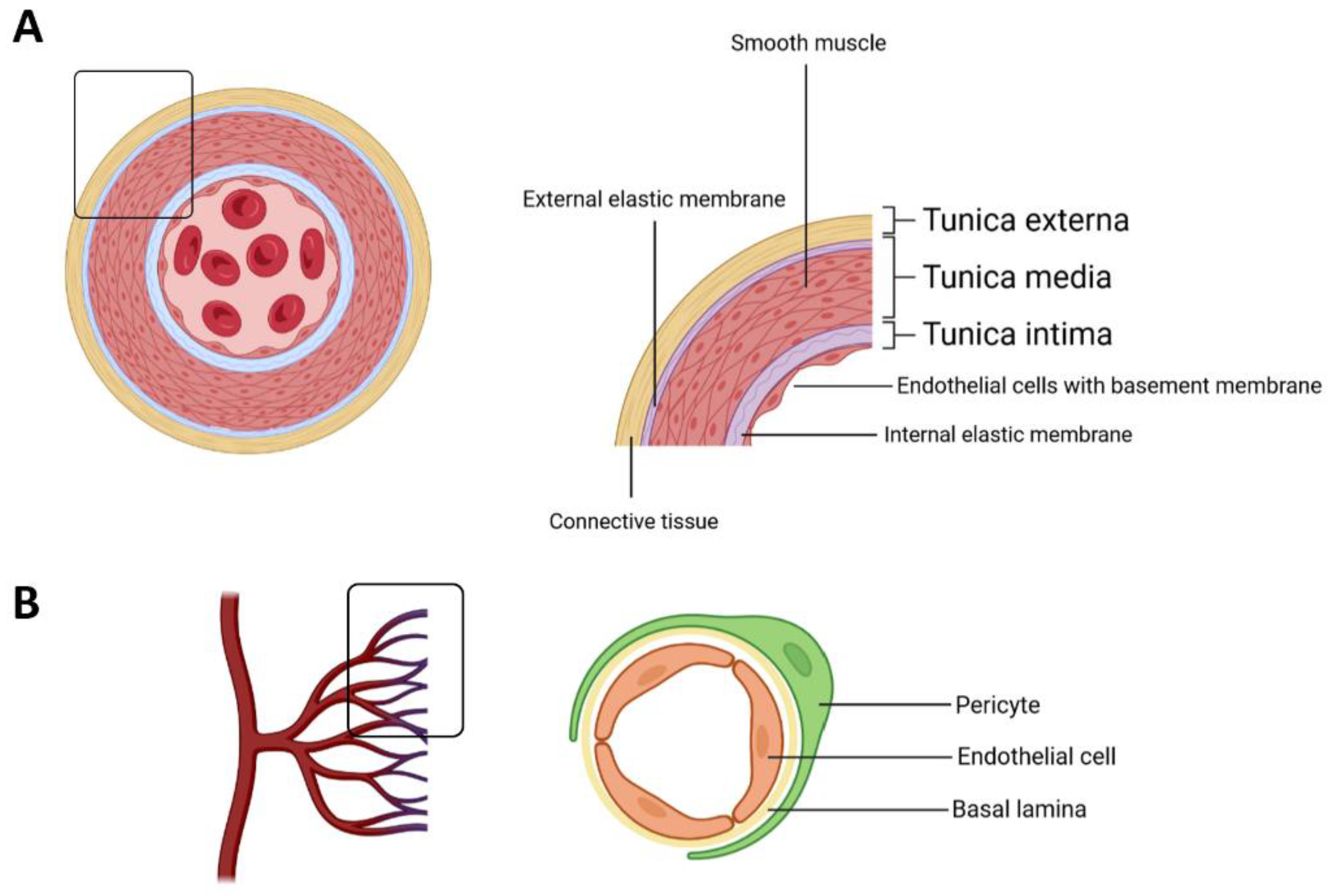Role of Endothelial Cell Metabolism in Normal and Tumor Vasculature
Conflicts of Interest
References
- Tucker, W.D.; Arora, Y.; Mahajan, K. Anatomy, Blood Vessels; StatPearls Publishing: Treasure Island, FL, USA, 2022. [Google Scholar]
- Kemp, S.S.; Lin, P.K.; Sun, Z.; Castano, M.A.; Yrigoin, K.; Penn, M.R.; Davis, G.E. Molecular basis for pericyte-induced capillary tube network assembly and maturation. Front. Cell. Dev. Biol. 2022, 10, 943533. [Google Scholar] [CrossRef] [PubMed]
- Murakami, M.; Nguyen, L.T.; Zhuang, Z.W.; Moodie, K.L.; Carmeliet, P.; Stan, R.V.; Simons, M. The fgf system has a key role in regulating vascular integrity. J. Clin. Investig. 2008, 118, 3355–3366. [Google Scholar] [CrossRef] [PubMed]
- van Hinsbergh, V.W. Endothelium–role in regulation of coagulation and inflammation. Semin. Immunopathol. 2012, 34, 93–106. [Google Scholar] [CrossRef] [PubMed]
- Pearson, J.D. Endothelial cell function and thrombosis. Baillieres Best Pract. Res. Clin. Haematol. 1999, 12, 329–341. [Google Scholar] [CrossRef] [PubMed]
- Pasut, A.; Becker, L.M.; Cuypers, A.; Carmeliet, P. Endothelial cell plasticity at the single-cell level. Angiogenesis 2021, 24, 311–326. [Google Scholar] [CrossRef] [PubMed]
- Paik, D.T.; Tian, L.; Williams, I.M.; Rhee, S.; Zhang, H.; Liu, C.; Mishra, R.; Wu, S.M.; Red-Horse, K.; Wu, J.C. Single-cell rna sequencing unveils unique transcriptomic signatures of organ-specific endothelial cells. Circulation 2020, 142, 1848–1862. [Google Scholar] [CrossRef] [PubMed]
- Ricard, N.; Bailly, S.; Guignabert, C.; Simons, M. The quiescent endothelium: Signalling pathways regulating organ-specific endothelial normalcy. Nat. Rev. Cardiol. 2021, 18, 565–580. [Google Scholar] [CrossRef] [PubMed]
- Kalucka, J.; de Rooij, L.; Goveia, J.; Rohlenova, K.; Dumas, S.J.; Meta, E.; Conchinha, N.V.; Taverna, F.; Teuwen, L.A.; Veys, K.; et al. Single-cell transcriptome atlas of murine endothelial cells. Cell 2020, 180, 764–779.e20. [Google Scholar] [CrossRef] [PubMed]
- Deanfield, J.E.; Halcox, J.P.; Rabelink, T.J. Endothelial function and dysfunction: Testing and clinical relevance. Circulation 2007, 115, 1285–1295. [Google Scholar] [CrossRef] [PubMed]
- Michaelsen, S.R.; Staberg, M.; Pedersen, H.; Jensen, K.E.; Majewski, W.; Broholm, H.; Nedergaard, M.K.; Meulengracht, C.; Urup, T.; Villingshoj, M.; et al. Vegf-c sustains vegfr2 activation under bevacizumab therapy and promotes glioblastoma maintenance. Neuro. Oncol. 2018, 20, 1462–1474. [Google Scholar] [CrossRef] [PubMed]
- Li, D.; Xie, K.; Zhang, L.; Yao, X.; Li, H.; Xu, Q.; Wang, X.; Jiang, J.; Fang, J. Dual blockade of vascular endothelial growth factor (vegf) and basic fibroblast growth factor (fgf-2) exhibits potent anti-angiogenic effects. Cancer Lett. 2016, 377, 164–173. [Google Scholar] [CrossRef] [PubMed]
- Frentzas, S.; Simoneau, E.; Bridgeman, V.L.; Vermeulen, P.B.; Foo, S.; Kostaras, E.; Nathan, M.; Wotherspoon, A.; Gao, Z.H.; Shi, Y.; et al. Vessel co-option mediates resistance to anti-angiogenic therapy in liver metastases. Nat. Med. 2016, 22, 1294–1302. [Google Scholar] [CrossRef] [PubMed]
- Li, X.; Sun, X.; Carmeliet, P. Hallmarks of endothelial cell metabolism in health and disease. Cell Metab. 2019, 30, 414–433. [Google Scholar] [CrossRef] [PubMed]
- Tsai, C.L.; Changchien, C.Y.; Chen, Y.; Lai, C.R.; Chen, T.M.; Chang, H.H.; Tsai, W.C.; Tsai, Y.L.; Tsai, H.C.; Lin, H.Y.; et al. Survival benefit of statin with anti-angiogenesis efficacy in lung cancer-associated pleural fluid through fxr modulation. Cancers 2022, 14, 2765. [Google Scholar] [CrossRef] [PubMed]
- Testa, E.; Palazzo, C.; Mastrantonio, R.; Viscomi, M.T. Dynamic interactions between tumor cells and brain microvascular endothelial cells in glioblastoma. Cancers 2022, 14, 3128. [Google Scholar] [CrossRef] [PubMed]
- Palazzo, C.; D’Alessio, A.; Tamagnone, L. Message in a bottle: Endothelial cell regulation by extracellular vesicles. Cancers 2022, 14, 1969. [Google Scholar] [CrossRef] [PubMed]
- Lidonnici, J.; Santoro, M.M.; Oberkersch, R.E. Cancer-induced metabolic rewiring of tumor endothelial cells. Cancers 2022, 14, 2735. [Google Scholar] [CrossRef] [PubMed]
- Filippini, A.; Tamagnone, L.; D’Alessio, A. Endothelial cell metabolism in vascular functions. Cancers 2022, 14, 1929. [Google Scholar] [CrossRef] [PubMed]
- Cutruzzola, F.; Bouzidi, A.; Liberati, F.R.; Spizzichino, S.; Boumis, G.; Macone, A.; Rinaldo, S.; Giardina, G.; Paone, A. The emerging role of amino acids of the brain microenvironment in the process of metastasis formation. Cancers 2021, 13, 2891. [Google Scholar] [CrossRef] [PubMed]


Disclaimer/Publisher’s Note: The statements, opinions and data contained in all publications are solely those of the individual author(s) and contributor(s) and not of MDPI and/or the editor(s). MDPI and/or the editor(s) disclaim responsibility for any injury to people or property resulting from any ideas, methods, instructions or products referred to in the content. |
© 2023 by the author. Licensee MDPI, Basel, Switzerland. This article is an open access article distributed under the terms and conditions of the Creative Commons Attribution (CC BY) license (https://creativecommons.org/licenses/by/4.0/).
Share and Cite
D’Alessio, A. Role of Endothelial Cell Metabolism in Normal and Tumor Vasculature. Cancers 2023, 15, 1921. https://doi.org/10.3390/cancers15071921
D’Alessio A. Role of Endothelial Cell Metabolism in Normal and Tumor Vasculature. Cancers. 2023; 15(7):1921. https://doi.org/10.3390/cancers15071921
Chicago/Turabian StyleD’Alessio, Alessio. 2023. "Role of Endothelial Cell Metabolism in Normal and Tumor Vasculature" Cancers 15, no. 7: 1921. https://doi.org/10.3390/cancers15071921
APA StyleD’Alessio, A. (2023). Role of Endothelial Cell Metabolism in Normal and Tumor Vasculature. Cancers, 15(7), 1921. https://doi.org/10.3390/cancers15071921




